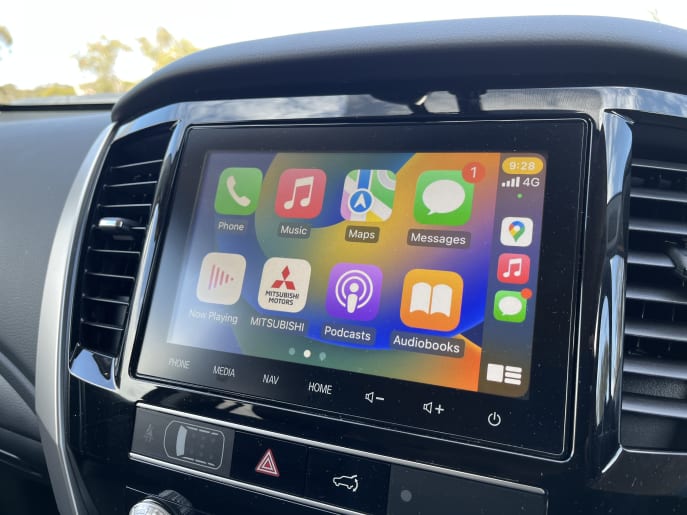It's sometimes ignored in favour of more hyped 4WDs, but the Mitsubishi Pajero Sport deserves more attention and respect.
It has a solid reputation as a very capable off-road wagon and it also functions well as a daily driver, without ever being over-the-top special.
The next-generation Pajero Sport is due here in 2025, but until then we wanted to see if the feature-packed top-spec GSR is worth your consideration, so we tested it for a week.
How much does the Mitsubishi Pajero Sport GSR cost?
The Mitsubishi Pajero Sport GSR has a recommended retail price of $65,440 (excluding on-road costs), but our test vehicle has premium paint (terra rossa, $200), electric brake kit ($689), towball ($41), carpet mats ($236), and towbar kit ($1495), which pushes the price as tested to $68,101 (excluding on-road costs).
What features do you get in the Mitsubishi Pajero Sport GSR?
Standard features onboard the Mitsubishi Pajero Sport GSR include an 8.0-inch touchscreen multimedia system (with Apple CarPlay and Android Auto), steering wheel paddle shifters, leather-appointed seats, power-adjustable and heated front seats, LED daytime running lights, Multi Around Monitor, dual zone climate control, 18-inch black alloy wheels and a power tailgate.
Exterior paint choices for the GSR include Terra Rosa, White Diamond and Black Mica.
The recently revealed 2024 Mitsubishi Triton offers several clues as to how well the 2025 Pajero Sport will be equipped and upgraded. The upcoming Triton will have a refreshed interior, a more modern multimedia system (with a bigger screen at 9 inches), and more driver-assist safety tech (including AEB with pedestrian and cyclist detection as standard across the range).
So, the 2025 Pajero Sport will benefit from those changes as well.
The Pajero Sport is 4825 millimetres long with a 2800mm wheelbase. It is 1815mm wide, 1835mm high and it has a listed kerb weight of 2125kg.
Its interior is a functional space, but it’s feeling a bit dated.
Up front, the seats (power-adjustable driver and front passenger) are very supportive, with a nice wrap-around feel to them.
The steering wheel has paddle shifters for sporty shifting and it is reach- and height-adjustable.
The dash and 8.0-inch touchscreen media unit are nicely integrated, but that screen is too small – and that’ll be rectified to some degree with the expected introduction of a 9.0-inch screen in the 2025 Pajero Sport.
All buttons and dials on the Pajero Sport are easy to locate and operate, even when you're bouncing around off-road.
The second-row seat has three top tether points, two ISOFIX points and a fold-down arm-rest with cup holders. There are USB charge points and a power socket in the back of the centre-console bin.
The second row is comfortable without being exceptionally so; I sat behind my driving position and there was plenty of head and leg room.
Passengers in the third-row seat have access to cup-holders and air vents.
The Pajero Sport has quite a narrow cabin compared to most of its rivals and there are plenty of other SUVs and 4WD wagons around that offer more room inside for people, gear and dogs.
Boot space is a listed 131 litres with the third-row seats in use; there are power sockets and tie-down points in that rear area.
With the third row folded out of the way, cargo space increases to 502 litres.
With the second and third rows stowed away, there is a combined 1400 litres of cargo space.
For reference, the 2024 Triton will be 15mm longer (5320mm, with a longer wheelbase 3130mm) and 50mm wider (1850mm) than the current generation model. And with the 2025 Pajero Sport set to follow suit, that’ll mean more space in the wagon’s cabin for driver, passenger, gear and your dogs.
The 2024 Triton’s newly developed ladder-frame chassis is claimed to have a 40 per cent increase in bending rigidity and a 60 per cent increase in torsional rigidity over the current generation.
The Pajero Sport has a 2.4-litre, four-cylinder, turbo-diesel engine, which produces 133kW at 3500rpm and 430Nm at 2500rpm, and it has an eight-speed automatic transmission.
This is a well-proven combination, rather than a dynamic one.
The GSR has Mitsubishi’s Super Select II 4WD system and a rear diff lock. There’s a Super Select II 4WD dial to the rear of the shifter, which enables the driver to switch from 2H (two-wheel drive), 4H (4WD high range), 4HLc (4WD High Range with locked centre diff) and 4LLC (4WD Low Range with locked centre diff).
The driver is able to safely switch between 2WD (2H) and 4WD (4H, 4HLc) at speeds up to 100km/h.
The GSR has a button-operated off-road mode system – with Gravel, Mud/Snow, Sand or Rock settings, each of which tweaks engine output, transmission settings and traction control to best suit the terrain – and hill descent control.
The 2024 Triton will retain the current-generation’s engine but it will have a twin-turbo and that will produce more power: 150kW at 1500rpm over the current engine’s 133kW at 3500rpm. The new Triton will have a maximum tuned torque figure of 470Nm; the outgoing Triton produces 430Nm. The upcoming Triton will keep the six-speed automatic transmission.
The 2025 Pajero Sport will have that new twin-turbo engine, but it’ll be paired with an eight-speed auto.
The maximum five-star ANCAP safety rating applies to Mitsubishi Pajero Sport vehicles built prior to January 1, 2023. Mitsubishi Pajero Sport vehicles built from 1 January 2023 are unrated.
Safety gear includes seven airbags (driver’s knee, driver and passenger front, driver and passenger front sides, and curtains) and this Pajero Sport’s suite of active safety and driver-assist tech includes AEB, adaptive cruise control, trailer stability assist, rear view camera and rear parking sensors, blind-spot warning with lane change assist, and rear cross-traffic alert.
The Pajero Sport’s AEB has a AEB City classification, which denotes that it is a system which only “operates at lower speeds (usually between 10-50km/h)”, according to ANCAP. It does not operate at higher speeds (“50-250km/h”), and it does not detect vulnerable road users, such as pedestrians, cyclists, or motorcyclists, when it is travelling at speeds of more than 50km/h.
The second-row seat has three child-seat anchorage points and an ISOFIX point on each outboard seat.
The Pajero Sport is covered by a 10-year/200,000 kilometre new car warranty, (whichever occurs first and when all scheduled services are completed at a Mitsubishi Dealership), 10 years of capped price servicing, and four years of roadside assistance.
Service intervals are set for 12 months or 15,000km, and capped price servicing covers the first 10 regular services at those scheduled 15,000km/12 month intervals.
The average cost per service (over 10 years) is $599 – and that’s been calculated by CarsGuide’s crack team of bean-counters.
What is the Mitsubishi Pajero Sport GSR like to drive?
The Pajero Sport is reasonable on-road, although it is quite sluggish, not very dynamic, a bit noisy and there’s quite a lot of body-roll through sharp turns.
But it is a very nimble and very capable off-roader, largely because the driver is able to tap into a few different ways engineered into it to help them conquer tough low-range challenges.
The GSR has selectable off-road modes, including Gravel, Sand, Mud/Snow (when in high-range 4WD) and Rock (when in low-range 4WD). Each of these modes adjusts engine output, transmission settings and braking, with the aim being to produce superior traction to suit specific conditions and terrains.
But one of the major points of difference with its rivals is the fact the GSR has Super Select II 4WD. You can switch, via a dial to the rear of the auto shifter, from 2H into 4H (four-wheel drive high-range), if you're not already driving with 4H engaged, and that gives you the best traction possible in low-traction conditions, which you may face on back-roads and dirt tracks.
There's no risk of transmission wind-up because the centre diff is open when 4H is engaged in the Pajero Sport, so Super Select II 4WD really does add an extra element of safety and sure-footedness to your driving experience.
Then turn the dial to 4HLc (four-wheel drive high-range locked centre diff) and you're ready to take on more difficult terrain but at lower speeds, because the centre diff is no longer open.
If you're keen to tackle even harder stuff than high-range territory, turn the dial to 4LLc (four-wheel drive low-range locked centre diff) and the Pajero Sport has a real opportunity to excel in low-speed low-range four-wheel driving.
So, along with decent high- and low-range gearing and a centre diff-lock – which is activated when 4HLc (4WD high-range, locked centre diff) or 4LLc (4WD low-range, locked centre diff) is selected – the Pajero Sport has a rear diff lock, which is engaged/disengaged via a button in front of the shifter and this further help you to easily maintain safe forward momentum.
Hill descent control sustains a controlled low speed of 3 to 4km all the way down steeper longer hills.
It's riding on Toyo Open Country A32 all-terrain tyres (265/60R18 110H) but it would perform even better with more aggressive rubber.
Wheel travel is okay, ground clearance (218mm) is reasonable, although you still have to mind your driving line through rough terrain and be mindful of approach (30 degrees), departure (24.2) and ramp-over (23.1) angles. Wading depth is listed as 700mm.
All-round, the Pajero Sport is an effective off-roader, and does everything in a safe and controlled way.
The upcoming Triton will also get a towing capacity boost from 3100kg to 3500kg, bringing it in line with its rivals.
So, following on from the Triton’s changes, the 2025 Triton-based Pajero Sport will be bigger, heavier and with greater towing capacity.
Official fuel consumption for the Pajero Sport GSR is 8.0L/100km on a combined cycle.
Its real-world fuel figure on this test, from pump to pump, was 9.6L/100km.
The Pajero Sport has a 68-litre tank, so, with that sort of fuel-consumption figure, you can reasonably expect a driving range of approximately 680km from a full tank, but that’s after having already subtracted a safe-distance buffer of 30km from the original total.
Is the Mitsubishi Pajero Sport GSR any good?
The Mitsubishi Pajero Sport is a sensible and comfortable family wagon as well as a very capable off-road vehicle.
And, in top-shelf GSR guise, it has plenty of standard features onboard.
Even though the whole package is feeling more than a little dated, the Pajero Sport represents a decent value-for-money option in an increasingly expensive car market.

















